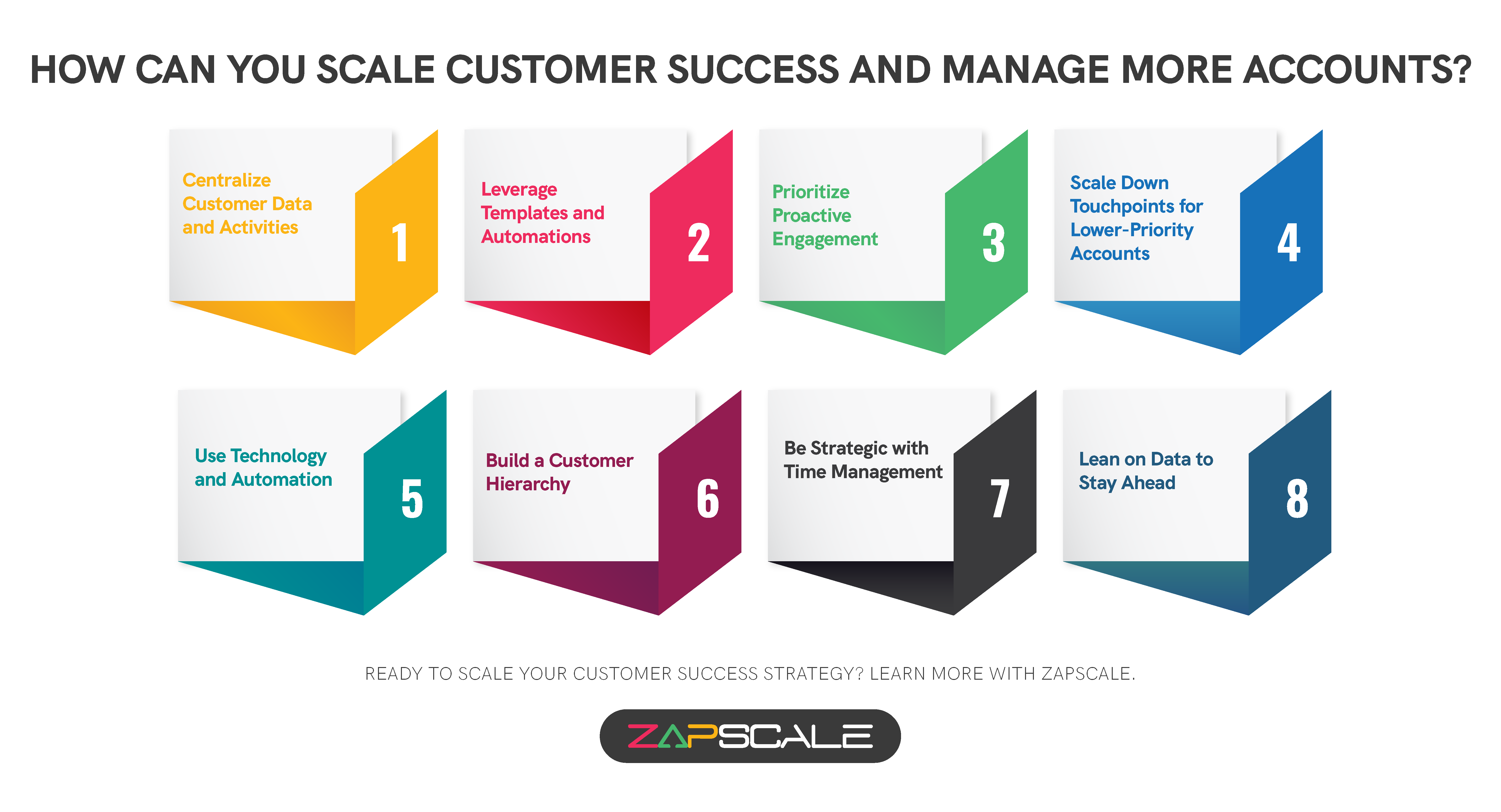CATEGORY > Customer Success Management
A Customer Success Manager’s Guide To Managing Customers At Scale

Introduction
Almost every customer success manager reaches a point in life where they feel the challenge of managing a growing number of accounts. It usually starts like this - you start with a manageable portfolio of customer accounts and then the portfolio quickly expands. Now, as the list of customers grows, so do the recurring meetings and the pressure to maintain a relevant and consistent line of communication with the customers. Scaling up can be quite overwhelming and hence staying organized and maintaining top-level customer service becomes a priority.
So how can you manage more accounts effectively without sacrificing the quality of your customer relationships? Let’s talk about some practical strategies to help you scale your efforts while keeping customer satisfaction at the forefront.

1. Centralize Your Customer Data And Activities
Having all your customer data in one place lays the foundation for managing a growing book of business. You need a robust customer success platform that can easily integrate all your customer-facing applications and centralize your customer interactions to make it easier to stay on top of critical tasks. Customer Success Platforms can help you segment customer data based on various parameters like ARR, health score, renewal date, etc. and effectively prioritize their needs. These insights can also help you create more personalized and targeted customer engagement strategies as well as identify early signs of churn or upsell.
The benefit of such a tech-driven tool in your customer success tech stack is that it gives complete customer visibility and automates your daily, repetitive customer-related tasks to help you run your CS strategy more efficiently.

2. Leverage Templates And Automations
As the number of accounts you manage grows, it becomes more crucial to streamline individual communications to reduce manual effort. Using templates in this case can result in multiple positive outcomes. Whether it’s for QBR recaps, follow-up emails, or product recommendations, pre-built templates allow you to craft messages quickly starting from scratch each time.
Automation tools in your customer success tech stack can help you automate regular check-ins, send reminders, or even flag accounts that haven’t been contacted recently. Automating repetitive tasks can free up your time for more strategic customer engagement.
Let’s take a basic example, after a call, instead of taking notes separately, you can create a follow-up email template that serves as both your notes and a recap for the customer. You can send the email, paste it into your tool, and mark the task complete. Simple tweaks like this save time and help you stay consistent across all your accounts.
3. Prioritize Proactive Engagement
Reactive customer success can be dangerous, especially when you’re handling a large number of customers since you’ll spend most of your time firefighting customer issues and only responding to issues as they arise. Proactive customer engagement means reaching out to customers before problems arise, offering them tailored solutions, and reinforcing the relationship. But it’s important to realize that not all customers need the same level of attention and engagement.
Segment your customers based on important KPIs (for example, their potential impact on your business). Ideally, high-value customers with significant potential for growth or churn should be your first priority. For mid-tier accounts, you can consider reducing the frequency of meetings and interactions, for example, while still monitoring their health and engagement.
For lower-value customers, your main focus should be on automating as many interactions as possible, for example, sending self-service resources or pre-scheduled health check emails.
The above paragraph is just an example of how segmenting customers the right way can help you prioritize customer engagement and save a lot of your time. It is of course not a one-size-fits-all rule, there are multiple variables involved for example if you’re operating on a high-touch or low-touch CS strategy.
4. Scale Down Touchpoints For Lower-Priority Accounts
Not all customers require the same amount of hands-on attention. A key strategy for scaling up is to scale down touchpoints for customers of lower strategic importance. If a weekly meeting isn’t necessary, consider moving to bi-weekly or monthly check-ins. Similarly, formal quarterly business reviews (QBRs) can be replaced by annual executive business reviews (EBRs) for accounts with lower annual recurring revenue (ARR) or limited expansion potential.
By reducing the frequency of touchpoints for less strategic accounts, you can focus your efforts on high-value customers while still maintaining a satisfactory level of engagement with others.
5. Use Technology And Automation Wherever Possible
Managing a large portfolio means balancing personalized service with operational efficiency. One of the best ways to do this is by integrating tools that reduce administrative burden. Many systems integrate directly with tech-driven tools like a customer success platform, allowing you to streamline processes like NPS surveys, customer health check-ins, and automated ticket generation. Tools like Slack, Asana, or Superhuman can also help you stay organized by managing tasks, automating responses, and creating reminders for critical actions.
Technology can help you handle the repetitive questions that come with managing multiple accounts. Implementing a knowledge base or a bot that handles common customer queries ensures that you’re not constantly reinventing the wheel. Automate what you can, and reserve your personal touch for the areas that truly need it.

6. Build A Customer Hierarchy
As your book of business grows, it’s important to create a hierarchy based on each customer’s importance. This can be done using metrics like monthly recurring revenue (MRR) or churn impact. Once you’ve segmented your customers, tailor your engagement accordingly:
- High churn impact customers should receive maximum proactivity. These are the accounts that can significantly affect your bottom line, so prioritize their satisfaction.
- Mid-tier customers should receive moderate proactivity, with recurring meetings scheduled less frequently (e.g., quarterly instead of monthly).
- Low-value customers should receive minimal proactivity, relying more on automated solutions and less on frequent touchpoints.
By categorizing your customers based on their business impact, you ensure that your limited time is spent where it will have the greatest return.
7. Be Strategic With Time Management
When managing a large portfolio, time management becomes critical. One helpful tactic is to schedule specific blocks of time for key tasks. For example, dedicate a few hours each week to QBR preparation or reaching out to customers with upcoming renewals. By grouping similar tasks together, you avoid the inefficiencies that come with constant context switching.
8. Lean On Data To Stay Ahead
Data is your friend when managing customers at scale. Customer success platforms often provide insights into customer health, product usage, and engagement trends. Use these insights to identify which customers are at risk of churn or which accounts could benefit from more attention. The more data-driven your approach, the better you’ll be at managing your growing portfolio without sacrificing the quality of service.

Conclusion
As customer success teams continue to grow their books of business, it’s crucial to have strategies in place to scale without burning out. By centralizing data, automating repetitive tasks, segmenting customers by priority, and leveraging technology, CSMs can maintain high-quality service while managing a larger number of accounts. Whether you're handling 30 or 100 accounts, the key is to remain organized, proactive, and strategic in how you manage your time and relationships.
ABOUT THE AUTHOR
Popular from Customer Success Management
Quality Content,
Straight To Your Inbox!
Subscribe for the latest blogs, podcasts, webinars, and events!

Write a Blog
If you have experience in CS and
a flair for writing, we’d love to
feature you.
Write to us on
hello@zapscale.com




